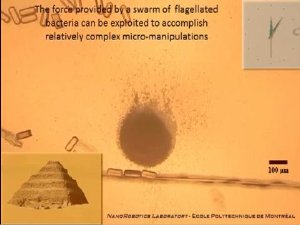Apr 6 2010
Faster than lion tamers... More powerful than snake charmers... Make way for the bacteria trainers! Professor Sylvain Martel and his team at the École Polytechnique de Montréal NanoRobotics Laboratory have achieved a new world first: "training" living bacteria to build a nanopyramid.

These miniature construction workers are magnetotactic bacteria (MTB): they have their own internal compasses, allowing them to be pulled by magnetic fields. MTB possess flagella bundles enabling each individual to generate a thrust force of approximately 4 picoNewtons. Professor Martel's team has succeeded in directing the motion of a group of such bacteria using computer-controlled magnetic fields. In an experiment conducted by Polytechnique researchers, the bacteria transported several epoxy nanobricks and assembled them into a step-pyramid structure, completing the task in just 15 minutes. The researchers have also managed to pilot a group of bacteria through the bloodstream of a rat using the same control apparatus.
A first in the world of science, this assembly of a structure by bacteria under human control opens up extremely promising avenues in the fields of medicine and bio-engineering; the researchers' ultimate goal is to make it possible to use MTB inside living organisms, by having them travel through the bloodstream. For example, they could carry drugs directly into the heart of tumours, function as pathogen detectors, repair organs, or operate micro-factories for conducting pharmaceutical or genetic tests.
Professor Martel's work gained widespread international attention in 2007 when his team became the first in the world to direct an untethered nanorobot through a blood vessel in a living animal. The new projects his team is currently working on include construction of a tiny, autonomous robot propelled by a microchip combining electronic components with MTB. The latter would be contained in microreservoirs, with the thrust they produce controlled by magnetic fields generated by nanoconductors inserted into the same reservoirs.
Founded in 1873, École Polytechnique de Montréal is one of Canada's leading engineering institutions in terms of both teaching and research. It is the largest engineering school in Québec in terms of the size of its student body and the scope of its research activities. École Polytechnique provides instruction in 13 engineering specialties and is responsible for more than one-quarter of Québec's university research in engineering. The school has 230 professors and nearly 6,300 students. It has an annual operating budget of close to $86 million, in addition to a $56.4-million research and infrastructure fund.
Swarm of Bacteria Builds Tiny Pyramid